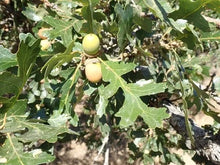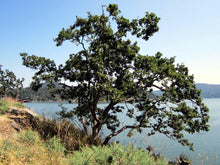|
Mature height x width: |
approx 50' x 50' |
|
Recommended initial spacing: |
5-10' in rows 25' apart |
|
Recommended final spacing: |
approx 50' apart |
| Hardy to: | approx -25°C |
|
Preferred soil: |
medium (loamy) and light (sandy) soils. |
|
Good for: |
marginal land, forest edge, savanna, livestock and wildlife food |
|
Uses: |
grain substitute (flour), eaten raw or cooked, coffee substitute (roasted). |
Garry oaks are an oak native to the Pacific Northwest.
Oaks have been an important food source for humans and animals throughout North America. In the territories of the Pentlatch, Qualicum, and K'omoks where we live, and on Coast Salish territories more broadly, Garry oaks (Quercus garyanna) are a crucial part of kwetlal food systems: an Indigenous savannah food system managed by controlled burns, providing abundant kwetlal (camas) harvests alongside acorns for humans and wildlife. Garry oaks are adapted to our dry summers, making them hardy and drought-tolerant. Like other oaks, Garry oak acorns have tannins, which need to be leached out by soaking them in water in order to make the nuts palatable for humans. Nuts can be roasted, boiled, or dried and milled into a flour.
Planting: While oaks can germinate and grow in a forest, these oaks do best in a sunny spot. They can tolerate acidic soils and a wide range of climates (growing as far north as Alaska and as far south as Texas). Oaks are wind-pollinated so they require at least two to make acorns. Planting several in the same area helps to ensure adequate pollination. Water for the first few years while they're getting established. Best planted when dormant (Nov-Mar) but can be planted later in spring.
Why bare root? "Bare root" means that the tree has been grown in the ground (rather than in a pot). In general, bare root trees tend to have larger root systems because their roots aren't constricted by the edges of the pot. Because we don't need to use pots or potting soil, we can sell them more cheaply than potted trees. Bareroot trees should be planted when they are dormant (Nov - Mar in the Pacific Northwest; Nov - Apr in colder climates).



